Questions of Curiosity While Exploring Newfoundland
This summer, my husband and I undertook a move. A relocation from Massachusetts to Arizona has been undertaken by others, no doubt. We decided to make things a little more interesting than a direct route. We headed north. Our circuitous route is winding us through Newfoundland, Portugal, and North Carolina. When one would think to take the southerly route from the Carolina’s to Arizona in the winter months, we will make Bugs Bunny’s famous right turn at Albuquerque to get to Bozeman, Montana. Then, we’ll drive to Arizona. Our 100 pound Golden Doodle, Kipper, was not consulted in the making of these plans, but we plied him with treats for the first three years of his life to the point he considers us his pack and blindly follows our direction. Our two sons weren’t consulted either. But, given that they abandoned us in their selfish quest to get a college education, we felt at liberty to leave a note on the front door explaining why other people now live in their house.

I started an argument between two Newfoundlanders. When my adult sons came for a week-long visit, we went on a whale watching tour. Void of any whales, we got to learn quite a bit about seagulls. Our captain was a wealth of knowledge, and pointed out the mammoth of all seagulls. Though we were told the name of this enormous gull, we promptly forgot it, and from then on our family referred to it as "the big ass seagull". The BAS was reported by our guide to be a predator of puffins. We were told it can eat upwards of 4 puffins in a day—and being the dutiful tour attendees that we are, we believed him. After all, if you were given your first boat to traipse around the Atlantic Ocean exploring the cliffs of Newfoundland at age 11 as our captain was and have lived by the sea for 60+ years, guiding whale-watching tours for 30 of it, in my mind you are granted an honorary degree in "I know more about gulls than you do." The Anselmis gave the appropriate level of surprised facial expression, satisfied nods to each other, and verbal confirmation of our attentiveness ("That's a lot of puffins!") before moving on to the other facts we gathered that day from our sea captain.

The BAS boat tour and sea captain
Then two of my dear friends from Massachusetts came to visit us in Newfoundland. We drove to the town of Trinity to go on a kayaking expedition in Trinity Bay.
Trinity Bay shares water and birds with the Atlantic Ocean. When I asked our young kayak guide if we would see any puffin eating BASes, he looked at me quizzically, chuckled, and replied, "Where'd ya' hear that?" All the gulls he knew of lived in harmony with or, at worst, were indifferent to puffins.
Gullible tourists! They'll believe anything!
But, apparently age and experience, on occasion, outshines youthful skepticism. Now that we have the ability to beam questions into space and teams of inner galactic savants retrieve answers from God's big book called "Stuff About Things I Made," we can end many a fact-based feud.
Whale-watch tour guide wins! The Great Black-Backed Seagull eats puffins.
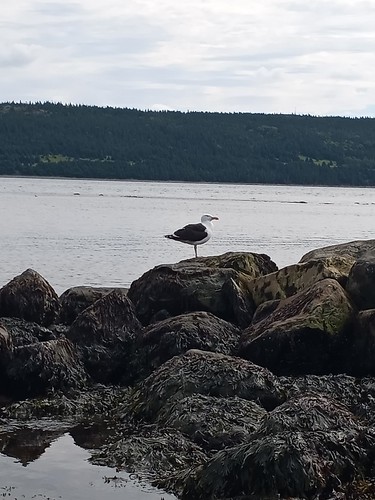
Mind your puffin-sized children around these gulls!
Much of the supposed wildlife in Newfoundland has gone unseen by my eyes. Moose here are numerous as ants...neither of which I’ve seen here. Whales frolic merely feet off shore in the hundreds...nix on those. Caribou roam and bears forage. I've seen birds.
Don't get me wrong, birds are amazing and beautiful and unique and interesting. Some people spend a lifetime behind the magnifying lens of binoculars to get fleeting glimpses of winged wonders. When I'm so often asked what animal I would be, I so often answer, "an eagle." I used to think I meant a bald eagle: fierce, confident, dramatic, soaring on wind currents and living the high life in trees. But my eyes have been opened to a far more grand vision for my incarnation...the Stellar Sea Eagle.

When my visiting friends and I pulled into the parking lot of our lodge in the adorable town of Trinity on the Bonavista Peninsula, we noticed the car next to us had a Massachusetts license plate. We noticed an older man standing on the deck of the inn, weighed down with two pairs of binoculars, a fully loaded hydration belt, a camera bag, and a camera with a lens the size of a dinner plate. Given there was only one car besides ours in the tiny parking lot and the inn appeared to be able to accommodate approximately five people, we astutely concluded the other Massachusetts car must belong to this gentleman and the woman standing next to him. Never one to pass up a chance to embarrass myself by imposing a question or comment on a complete stranger, I said, "Looks like the grandkids are going to be the subjects of a few close ups today." They stared blankly, then quickly moved aside to let us pass.
The next morning, the wife of the couple entered the small dining area of the inn where I was sitting alone looking at a map. Upon seeing me, she must have remembered she left something in her room because she started to walk out, but I was well rested and had a head full of questions. Yes, they were from Massachusetts (knew it!). They had been in Trinity for three days. It was their first time in Newfoundland. They drove up after hearing someone in Trinity had spotted the Stellar Sea Eagle—and being rabid bird-finding people, they threw their equipment in the car and high-tailed it to northern Newfoundland. What?! To find one bird?! My head full of questions had to reboot and reshuffle my deck of questions.
Why is that bird so special?
Where does the Stellar Sea Eagle usually live?
How many of them are here?
What does it look like?
How long has it been here?
How long have you been birding?
Where have you traveled to go birding?
Do you keep a list of birds you've seen?
On and on and on.
Apparently, the Stellar Sea Eagle is only found in Southern Russia and Japan. One of them (ONE single member of this group of birds!) left and flew to North America, where it had been spotted above Trinity Bay for the past several days. This birding couple jumped in the car upon hearing that news and here they were. When asked where else in the world they had gone birding, she mentioned going with a birding group to parts of Africa (knock off, lions! You're blocking my view of that Pied Crow!). This was fascinating to me! And right then and there, I decided I would not only be a Stellar Sea Eagle, I would be THE Stellar Sea Eagle...the one that makes people travel across land, sea, and sky to catch a glimpse of my magnificence.
We had a tremendous kayaking experience with our private guide, Darrell. After he quickly assessed our kayaking skills and surmised that we were weak kayakers with a tremendous amount of enthusiasm, he took us out of the Trinity Cove and into Trinity Bay.

Adorable town of Trinity
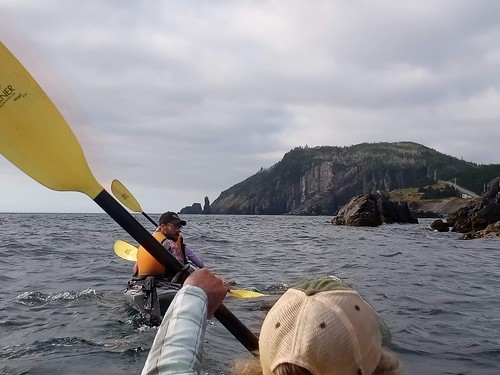
Out of Trinity Cove and into Trinity Bay
Let's think of Trinity Bay as an ever so slightly narrower Atlantic Ocean. He taught us about swells, currents, winds, and waves as he led us past Cliffs of Insanity (must watch The Princess Bride), amongst sea stacks, and between tickles. A tickle is a very narrow waterway between two sea stacks or between a cliff and a sea stack wide enough to barely allow your vessel to squeeze through. I was Lee Ann's wingman in our double kayak, and with her sense of fear and my sense of humor we were terrible at communicating, but fared better than Maverick and Goose in the end.
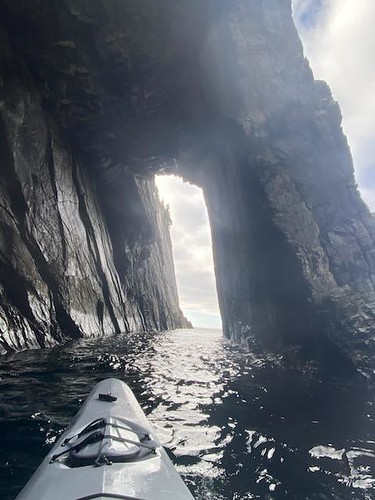
About to go through a tickle
When we paddled up to shore at the end of the tour, three scruffy dock workers were taking a cigarette break by a dilapidated fishing shed. Our guide knew them (Trinity is a town of 170 people). He asked if any of them had seen the Stellar Sea Eagle. Two of the three fishermen said they had heard about it but hadn't seen it. The third fisherman, a large, burly, unshaven gent with a thick Irish accent looked painfully perplexed. "Peoples 'er travelin' har to see one bird?," he asked. When we answered in the affirmative, he queried, "Whut’s better 'bout that eagle, then the one we already got around here?"
My love for ALL of humanity from all walks of life grew three sizes that day.
After Trinity, we pointed the car north with Elliston, Newfoundland as our next destination. Elliston has two claims to fame. On its welcome sign, it boasts "Root Cellar Capital of the World." In fact, it does have a staggering number of accessible and self-guided root cellars within the 3.8 miles that make up the town. Root vegetables grow well in the rocky Newfoundland soil. So, prior to refrigeration, areas were dug out under ground so you could enjoy your parsnips and beets all year long.
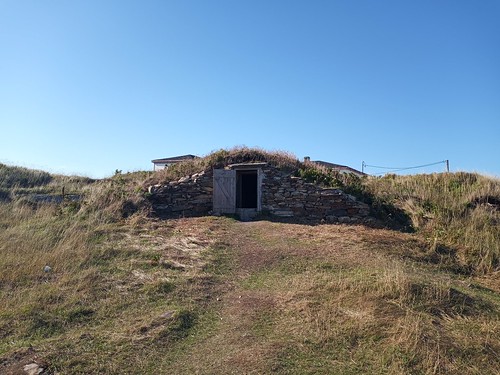
One of Elliston's famous root cellars
But we were in Elliston for its other famed landmark...the island of the puffins. At the height of the season, there are roughly 600 puffins on the top of a smallish sea stack off the coast. We walked the short (ridiculously windy) trek to the viewing spot ,where approximately 12 other people were sitting panning the sea stack for signs of the 10 inch tall avians. September is late for puffins in Newfoundland. More than one person warned us that our trip to Elliston to see the little orange-beaked guys might disappoint. But three enthusiastic and determined women can make anything happen! It wasn't easy at first. It required a great deal of verbal questioning…
"Do you see any?"
"No. You?"
"I see seagulls."
"How big are they?"
"I don't know. Do you think we'll be able to see the orange on their beak?"
"Is that one?!"
"Maybe they've gone off to hunt."
Then,...
"Wait! There's one!"
"Where?!"
"Give me the binoculars!"
"Right there!"
"Oh! Yeah! I see it!"
"There's another!"
"WOW! There's a few more!"
"How cute!"
"Want the binoculars!?"
"Look at that one fly!"
(Pause. Silence.)
Glancing around, my friend Kris asked, "Where did all the people go?"
"Weren't there other people here when we arrived?"
"They probably thought there were no puffins on the island."
"They are hard to see."
"We had to be very patient to find that first one. Maybe they just aren’t as patient as us."
(Pause. Silence.)
Kris: "Hmm. Is birding a quiet activity?"
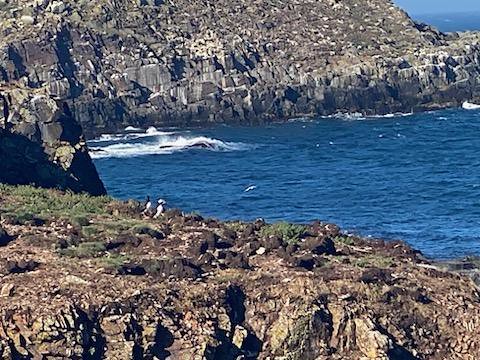
Can you spot the puffins?
John and I alone, then with our sons, then with my friends, have tried to fit a week's worth of activities into each day. Even so, we will not do or see half of what we want to in our eight weeks on this rock. There was only one section of the Avalon Peninsula John and I hadn't been to, so last weekend we set off to cover that ground. Our ultimate destination was the St. Mary's Ecological Reserve to the south, famed for its enormous population of summering birds. I was as done with seeing and hearing about birds as you probably are reading about them, but this was about the destination, NOT the journey!
We quickly became enthralled with the differences in the landscape along the west side of the Avalon, compared to the east. I mean, really, how many ways can the Earth put together rocky cliffs, water, and lowlands? Apparently a few more ways!
We stopped at Castle Hill National Historic site in Placentia to walk amongst and read about the old French fortress meant to keep England's dominance on the island in check. (England's troops ate less Nutella-filled crepes over time, and were eventually able to out-maneuver the French.)

Castle Hill National Historic site
John, who loves visiting historic military posts, left Castle Hill exhausted for some reason. One of us (cue selfie of me) was full of questions, and the other has extensive experience in the military.
"What's a garrison, breastworks, bivouac, bastille, battery, turret, parapet, rampart, billet,...???”
My mom has taken up referring to me as Dora. Remember that annoyingly cheerful, energetic, insatiably curious cartoon character of the early 2000s?
Before taking the 20 minute walk out to the bird viewing area at St. Mary's Ecological Preserve, we stopped in the museum, where we read information about the six varieties of birds that come to the area each summer. It was the end of most of their summer vacations. The lady at the information desk sympathetically told us the only bird left in town was the gannet. Weeks ago, we had watched gannets outside the large windows of the Clarke's Beach Distillery with some fascination. They fly straight up, then turn straight down with tucked wings and plummet into the water to get fish. Concussion issues in the population must be rampant.
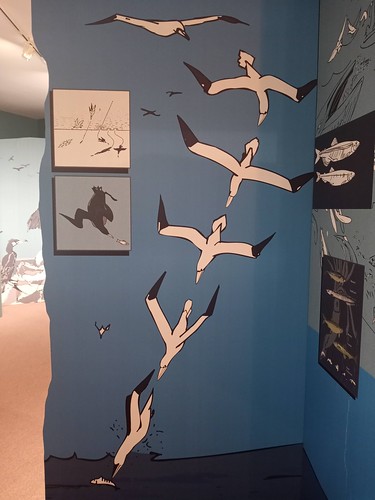
Plunging gannet
Being uninspired to see the few gannets anyway, but obligated by proximity, we moseyed to the viewing area. As we got closer, it became increasingly difficult to hear each other. The sky swarmed with swooping, diving, drifting, hovering winged creatures. At the cliff's edge, we saw THOUSANDS of gannets perched on sea stacks and the side of cliffs!
I got very excited!
They were all talking at once. Squawking, chirping, tweeting, chattering, trilling. And they were in constant motion! It was like a football stadium-filled shoulder to shoulder with Christys! Talking, moving, questioning, solving, asking, commenting, instructing, exploring, soaring...Finally I found my people...it's just that they are birds! My overwhelmed husband retreated after a surprisingly short time amongst the birds.

Gannets at St. Mary's Ecological Preserve
“Where are you going?! Look at this! This is incredible! Why do they all congregate here? Do their babies come back to the same place? What do you think their communications mean? I wonder how they get along with the other birds that come here., ….”
My husband was not within earshot of my wonderings at this point, having removed himself from the human and bird-generated cacophony. Maybe his kinship is more with Newfoundland's solitary and elusive moose. Well, I suppose after 20 plus years of marriage, it’s fair to say that birds of a feather sometimes flock with birds of fur.
Please click the photo below for a collection of my Travel with Awe and Wonder columns:
Christy Anselmi, the Travel with Awe and Wonder Editor for Wandering Educators, taught kindergarten and first grade for 13 years in public schools in Atlanta and Massachusetts. She took a two year diversion to teach and learn in a Montessori school in Bozeman, Montana and a 10 year sabbatical to raise her own children. Christy has an abiding interest in early childhood education and how to provide developmentally appropriate experiences to engage young people in connection and communication. Raised by parents who got Christy involved in travel at a young age, she developed a curiosity about what is around each corner. Married to a Wyoming man who developed his own wanderlust after years in the Army, the two (along with two sons) have lived in five states (Georgia, Montana, Utah, Kansas, Massachusetts, and soon to be Arizona) and one country (Germany). Christy is a life-long noticer of intriguing scenarios, phrases, and ironies in everyday life. Finally putting pen to paper, she has a growing passion for insightful travel-experience writing.


















